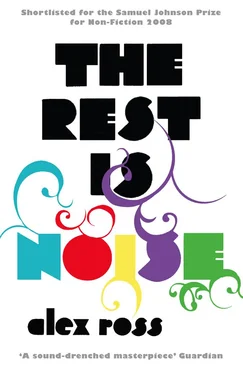Janáček’s creative Indian summer is often attributed to his infatuation with Kamila Stösslová, a young married woman whom he met in 1917. Richly imagined female characters populate his last works: the “dark-skinned Gypsy girl” who seduces a farmer’s son in the song cycle The Diary of One Who Disappeared; Katerina, the tragic heroine of the opera Katya Kabanova, who throws herself into the Volga River to escape the tormenting rectitude of her mother-in-law; the female fox at the heart of the animal fable The Cunning Little Vixen, who finds love in the forest and then falls to the gun of a poacher; and the unlikely protagonist of The Makropoulos Affair, a 337-year-old opera singer who has achieved immortality at the price of being “cold as ice.”
Janáček’s late style is lean and strong. Melodies are whittled down but do not lose their grace. Rhythms move like a needle on a gramo-phone, skipping as if stuck in a rut or slowing down as if someone were fiddling with the speed. One signature sound is a raw pealing of trumpets, which ushers in both the rustic military Sinfonietta and the Glagolitic Mass, a setting of the Old Slavonic liturgy. In the mass, liturgical phrases such as “Lord have mercy,” “Crucified for us,” “I believe,” and “Lamb of God” are linked to changing phases of rural weather: lashing rain, lightning, a clearing sky, a spell of moonlight, a pale sun the following day. Christianity and paganism are reconciled.
The Cunning Little Vixen, at once a charming children’s tale and a profound allegory of modern life, may be Janáček’s greatest achievement. It begins innocuously, as a folksy old forester—as a child Janáček dreamed of being a forester—captures a fox cub and brings her to his home. She runs amok, slaughters the chickens, and is banished to the woods. There she finds a handsome lover and woos him to music that parodies post-Wagnerian opera, notably Strauss in his kitschier moods. In Act III, the vixen is felled by a rifle shot, and the opera takes on an altogether different tone. In the final scene the forester steps out of his folk-tale role and meditates on the passage of time. He seems to be musing about the very opera that he’s in: “Is this fairy tale or reality? Reality or fairy tale?” The forester falls asleep, and when he wakes the animals of the woods surround him. He sees fox cubs at play and realizes that they are the vixen’s children. He then catches a little frog in his hand, thinking he’s seeing the same “clammy little monster” whom he met in the first scene of the opera:
FORESTER: Where have you come from?
FROG: That wasn’t me, that was grandpa! They told me all about you.
In other words, the animals of the forest have been telling stories about the forester over the course of their brief lives, as if he were a hero from long ago. In the disjuncture between human and animal time we see him—and ourselves—across an immense space. “Good and evil turn around in life afresh,” Janáček wrote in his own synopsis.
The forester smiles and goes back to sleep. His gun slips from his hands. The vixen’s music returns, raised to extraordinary vehemence by pealing brass and pounding timpani. A circular motif plays twice over chords of D-flat major, then modulates to E major; finally, as the harmony returns to D-flat, the melody clings to its E-major pitches, producing a rich modal sonority, a bluesy seventh chord. It recalls the ending of Jenůfa, the walk into paradise. “You must play this for me when I die,” Janáček said to his producer. Which they did, in August 1928.
Stravinsky’s moment of high anxiety arrived when he performed his Piano Sonata at the 1925 ISCM festival in Venice. Janáček was there; so, too, were Diaghilev, Honegger, the Princesse de Polignac, Cole Porter, Arturo Toscanini, and Schoenberg, with his red gaze. Many questioned Stravinsky’s new neoclassical style; the rumor went around that he was no longer “serious,” that he had become a pasticheur. Schoenberg reportedly walked out. Stravinsky must have been aware of the skepticism all around; insecurity, writes his biographer Stephen Walsh, was “the demon that lurked permanently in the inner regions of Stravinsky’s consciousness.” Emotional tensions preyed on him as well. Yekaterina Stravinsky, his wife, had suffered a breakdown, the result of a tubercular condition. Yekaterina’s devotion to Russian Orthodoxy seemed a silent rebuke of her husband’s dandyish lifestyle, not to mention his ongoing affair with Vera Sudeykina.
A few days before the concert, an abscess appeared on Stravinsky’s right hand. Somewhat to his own surprise, he went to a church, got on his knees, and asked for divine aid. Just before sitting down to play, he checked under the bandage and saw that the abscess was gone. This sudden cure struck Stravinsky as a miracle, and he began to experience a religious reawakening. His official “return to sacraments” took place almost a year later, during Holy Week of 1926, when he reported to Diaghilev that he was fasting “out of extreme mental and spiritual need.” Around the same time, Stravinsky wrote a brief, pungent setting of the Lord’s Prayer in Old Slavonic. Over the next five years he wrote a trilogy of solemn-toned or explicitly sacred works: Oedipus Rex, Apollo, Symphony of Psalms. Religion was his new “reality,” his new foundation; it gave substance to his devotion to the past and, not incidentally, direction to his mildly dissolute life.
In rediscovering religion, Stravinsky was, paradoxically, following fashion. The year 1925 was one of newfound sobriety in French culture. Many were pondering a valedictory essay by the recently deceased Jacques Rivière on the “crisis of the concept of literature”; the critic had proposed that the arts were becoming too disinterested, too “inhuman,” and he listed Stravinsky’s “music of objects” among the symptoms of an ethical and spiritual decline. Cocteau, having suffered the loss of his underage lover Raymond Radiguet, fallen into opium addiction, and experienced a hallucinatory epiphany in Picasso’s elevator, returned to Catholicism in June of the same year. Cocteau’s guru was the neo-Thomist philosopher Jacques Maritain, who believed that modern art could purify itself into an image of God’s truth, into something “well made, complete, proper, durable, honest.”
Stravinsky, too, fell under Maritain’s influence, perhaps chastened when the philosopher criticized the notion of “art for nothing, for nothing else but itself.” After considering the idea of an opera or oratorio on the life of Saint Francis of Assisi, Stravinsky elected to pursue a topic from ancient tragedy, and asked Cocteau to write a French-language adaptation of the story of Oedipus. He then had Cocteau’s text translated into Latin. “The choice [of Latin],” Stravinsky later wrote, “had the great advantage of giving me a medium not dead, but turned to stone and so monumentalized as to have become immune from all risk of vulgarization.” The score instructed: “Only their arms and heads move. They should give the impression of living statues.” This marked a commitment to Rivière’s project of spiritual rehabilitation, to Maritain’s philosophy of art as sacred work.
Cocteau’s involvement meant that Oedipus could go only so far in the direction of solemnity. The Latin declamations were strung together with a self-consciously, satirically pompous French-language narration. Cocteau’s Speaker is so wrapped up in his literary dignity that he sometimes fails to notice what is happening onstage. “And now you will hear the famous monologue, ‘The Divine Jocasta is dead,’ ” he proclaims—but no monologue ensues.
Such self-conscious gestures might have turned Oedipus into another panoply of camp. But Stravinsky was in earnest. “Kaedit nos pestis”—“Plague is upon us”—the chorus chants at the opening, over five booming chords in the key of B-flat minor. On its own, the core progression would sound a bit creaky and clichéd. What adds drama is the bass line, which sticks to the notes of the B-flat-minor triad but gnashes against the changing chords above. The impression, here and throughout the work, is of damaged, decaying grandeur—like acid streaks on cathedral marble. Yet Oedipus is a living statue, as the score instructs. Stravinsky’s alertness to the rhythm of words puts bounce and thrust into the archaic Latin text. The word “moritur,” coming at the end of the three opening gestures, sets in motion a purring triplet figure that propels the work to the end.
Читать дальше












